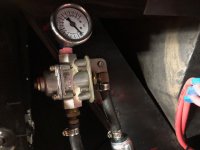D
Deleted member 21150
Guest
Guest
Offline
My engine is set up with a fuel pressure regulator, but it didn't have a pressure gauge. I wanted to see what my fuel pressure is so I bought a gauge and installed it on the regulator. With the key in the on position the fuel pump turns on but I'm not seeing any pressure at the gauge?? How can this be?(engine runs fine) Shouldn't I see pressure at the gauge with the key on? I didn't start the engine today to see if there was any difference, raining today. This is on a Chevy 350.

 Hi Guest!
Hi Guest!

 smilie in place of the real @
smilie in place of the real @
 Pretty Please - add it to our Events forum(s) and add to the calendar! >>
Pretty Please - add it to our Events forum(s) and add to the calendar! >> 


